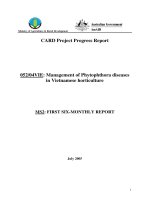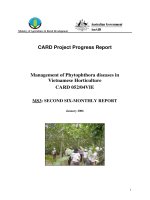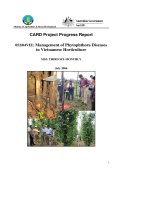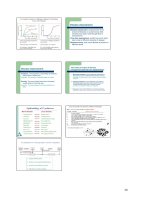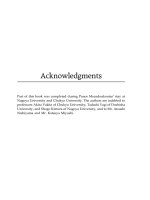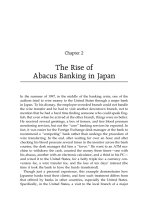Adoption of Mobile Banking in Vietnamese urban areas
Bạn đang xem bản rút gọn của tài liệu. Xem và tải ngay bản đầy đủ của tài liệu tại đây (1.66 MB, 64 trang )
NATIONAL ECONOMICS UNIVERSITY
NATIONAL ECONOMICS UNIVERSITYNATIONAL ECONOMICS UNIVERSITY
NATIONAL ECONOMICS UNIVERSITY
NEU BUSINESS SCHOOL
NEU BUSINESS SCHOOLNEU BUSINESS SCHOOL
NEU BUSINESS SCHOOL
NGUYEN THI HUONG AN
adoption of Mobile Banking
in Vietnamese urban areas
Supervisor : Dr. LE THI BICH NGOC
Hanoi - 2013
i
ACKNOWLEDGEMENT
I would like to thank Dr. Le Thi Bich Ngoc, my instructor, who has provided
me very valued guidance throughout the course of my thesis. Her every specific
advice and promptness, despite her busy schedule was instrumental in getting my
research work organized in its final shape. I offer my sincere thanks to her.
Any research of this nature cannot be successful without the active
involvement of people who participate in the survey. I would like to thank all of
respondents. My colleagues and friends in banking industry were very co-operative
and provided me valuable inputs. I would like to express my gratitude to them.
I would like to give my thanks to the family members who sustained my
grumpiness and moods during the process of compiling this research work. In fact,
they went beyond that and motivated me immensely throughout.
Sincerethanksalsogo to the Business School of Hanoi National Economics
University where I got a good chance to attend the very useful MBA course.
Hanoi, September 2013.
ii
TABLE OF CONTENTS
ACKNOWLEDGEMENT i
TABLE OF CONTENTS ii
ABRIVIATION iv
LIST OF TABLES v
LIST OF FIGURES vi
EXECUTIVE SUMMARY 1
CHAPTER 1: INTRODUCTION 3
1.1. Rationale 3
1.2. R esearch objectives& research questions 4
1.3. The research targets are: 4
1.4. Research methodology 6
1.4.1. Data collection 6
1.4.2. Research process 6
1.5. Scope of study 6
1.6. Limitations of study 7
1.7. Thesis structure 7
CHAPTER 2: THEORETICAL BACKGROUND 9
2.1. Fundamentals of mobile banking 9
2.2. U taut model 13
2.3. The factors affecting adoption of mobile bankingin vietnam 16
2.3.1
Performance Expectation 16
2.3.2 Effort Expectance 17
2.3.3 Social influence 18
2.3.4 Perceived financial cost 18
2.3.5 Perceived credibility 19
iii
CHAPTER 3: CURRENT SITUATIONS OF USING MOBILE BANKING IN
VIETNAM 21
3.1.
Global mobile banking trends 21
3.2. Current situations of using mobile banking in vietnam 22
CHAPTER 4: FINDINGS ABOUT VIETNAMESE CUSTOMERS’
ADOPTION OF MOBILE BANKING 29
4.1.
Research methodology 29
4.1.1. Methodology 29
4.1.2. Research process 29
4.1.3. Sample selection 30
4.1.4. Questionnaire design 30
4.2. Data analysis 32
CHAPTER 5: RECOMMENDATIONS TO ATTRACT MORE
VIETNAMESE CUSTOMERS USING MOBILE BANKING 40
5.1. Increase perceived usefulness 40
5.2. Promoting marketing and customers relationship 40
5.3. Increase the level of security 41
5.3.1. Risk based authentication 42
5.3.2. Mobile Application 42
5.3.3. One – time passwords 43
5.3.4. Biometric authentication 44
5.3.5. Educating people on how to protect their information 45
5.3.6. Digital signature 46
5.4. Increasing perceived ease of use for older people 47
5.5. Building policy 47
REFERENCES 49
iv
ABRIVIATION
DTPB The Decomposed Theory of Planned Behavior
EE Effort Expectance
FC Facilitating Conditions
HTTP Hypertext Transfer Protocol
IDG International Data Group
IDT Diffusion of Innovation Theory
IVR Interactive Voice Response
MB Mobile Banking
MM Motivational Model
MPCU The Model of Personal Computer Utilization
PC Perceived Credibility
PDA Personal Digital Assistance
PE Performance Expectance
PFC Perceived Financial Cost
RBA Risk – based Authentication
SCT Social Cognitive Theory
SI Social Influence
SMS Short Message Service
TAM Technology Acceptance Model
TPB The Theory of Planned Behavior
TRA The Theory of Reasoned Theory
UTAUT Unified Theory of Acceptance and Use of Technology
WAP Wireless Access Protocol
v
LIST OF TABLES
Table 2.1: Summary of Research findings on factors affecting technology adoption 14
Table 4.1: Dimensions and factors affecting using of Mobile Banking in Vietnam 31
Table 4.2: Demographic profiles of respondents 32
Table 4.3: Mean score and standard deviation of survey on Mobile Banking 35
vi
LIST OF FIGURES
Figure 2.1: The Unified Theory of Acceptance and Use of Technology (UTAUT) 16
Figure 2.2: The proposed research structure 20
Figure 4.1: How survey customers interact with banks 34
vii
1
EXECUTIVE SUMMARY
Fast advances in the wireless technology and the intensive penetration of cell
phones have motivated banks to spend large budget on building Mobile
Banking systems.In many countries, Mobile Banking has gained wide
acceptance and Vietnam is no onlooker to this phenomena. Banks in Vietnam
started embracing technology in a massive way in the 2000’s, led in particular
by the new private banks and multinational banks. However, the adoption rate
of Mobile Banking in Vietnamese urban areas is still underused than
expected.Therefore, research to enrich current knowledge about what affects
individuals to use Mobile Banking is required.
Consequently, this study employs the Unified Theory of Acceptance and Use
of Technology (UTAUT) to investigate what impacts people to adopt Mobile
Banking.A research was carried out to see what factors affecting adoption of Mobile
Banking in Vietnam. The data is organized using Likert seven – point scale to
access each response of the participants. Quantitative methodology is used to
analyze the collated numeric data. The questions are grouped and mapped to each of
the identified factor groups. The average score for each issue has been worked out
based on this grouping.
Through sampling 309 respondents, this study empirically concluded that
individual intention to adopt Mobile Banking was significantly influenced by
performance expectancy, social influence, perceived credibility and perceived
financial cost. On the other hand, effort expectancy was proved that it was not a
significant factors that affecting adoption of Mobile Banking.
Based on the finding result above, there are a number of recommendation
that has been suggested to improve the quality of Mobile Banking service in
Vietnam and in order to attract more customers to use the services. The bank should
increase the perceived usefulness of Mobile Banking, promote marketing and
2
customer relationship, increase the level of securities by using risk based
authentications, mobile application, one – time password, biometric authentication
such as finger print or iris scan and educate people how to protect their own
information or use digital signature. Then the bank should focus on increasing the
perceived ease of use for old people and building policy to fulfill the quality of the
Mobile Banking services for customers.
3
CHAPTER 1: INTRODUCTION
1.1. Rationale
Mobile Banking is creating dramatic changes for the banking industry.
Mobile Banking is a system that allows customers of a financial institution to
conduct a number of financial transactions through a mobile device such as
a mobile phone or Personal Digital Assistant (PDA). Mobile Bankinghelps
consumers in conducting fast and convenient financial transaction activities.
In many countries, Mobile Banking has gained wide acceptance and Vietnam
is no onlooker to this phenomena. Banks in Vietnam started embracing technology
in a massive way in the 2000’s, led in particular by the new private banks and
multinational banks. The growing competition andgrowing expectations led to
increased awareness amongst banks on the role and importance of technology in
banking, forcing banks to go in for the latest technologies so as to meet the threat of
competition and retain their customer base.
There are a lot of benefits through adoption of Mobile Banking for the banks
and their customers, those benefits would be mentioned in more detail in chapter 2
of this study. Not only that, Mobile Banking also help the economic to develop, so
that it also has benefits for the society. It created a new mode of operation,
contributing to the economic and commercial activities, services and tourism
development, facilitating open extensive trade and economic cooperation with other
regions in the world.
Vietnamese commercial banks realize the huge advantages of Mobile
Banking for them as well as the customers, they had spent large budget on building
Mobile Banking systems, but the adoption rate of Mobile Banking is still underused
than expected. Although in recent year, the number of Mobile Banking users has
4
grown rapidly, there is some evidence supporting that Mobile Banking acceptance
is faced with problems,the evitable result is that the huge number of people who
tried Mobile Banking services had not become active users. The possible reason
could be the customer still doubt about the benefits of Mobile financial services and
the level of securities provided along with such services. Therefore, the purpose of
this report is to investigate the factors that affecting the adoption of Mobile Banking
in Vietnamese urban areas.
This study could be of special interest and value to the banking sector and
other commercial sectors linked to banking. The findings and recommendations to
banks could help them to analyze and restructure their strategy to attract customers.
The banking industry can attract potential customers towards Mobile Banking by
taking into account the factors influencing user decisions or preferences. Other
researchers and allied industries may use the results by analyzing the behavior and
resistance patterns of customers leading to innovations.
1.2. R esearch objectives& research questions
1.3. The research targets are:
• To review the theoretical framework in Mobile Banking.
• To assess the current situation of using Mobile Banking in Vietnamese urban
areas in recent years.
• To study factors influencing on the customers’ adoption of using Mobile
Banking in Vietnam.
• To recommend solutions for improve the number of customers using Mobile
Banking in Vietnam.
Hence, the questions for this research would be:
• What theories could be applied in study of Mobile Banking adoption?
• How Mobile Banking is applied now in Vietnam?
• What factors influencing the customers’ adoption of using Mobile Banking
in Vietnam?
5
• What could be done to increase the number of Vietnamese customers using
Mobile Banking?
6
1.4. Research methodology
1.4.1. Data collection
The research both use secondary data and primary data to figure out the
factors that affectingMobile Banking adoption in Vietnam.
∗ Secondary data
Secondary data is pre – existing data collected in the past for another
purpose. The information collected is not only expressed by figures but also by the
real activities of doing research investigating Mobile Banking adoption all over the
world. The secondary data in this research includes information from various model
theories that developed by a number of authors and were proved by many empirical
tests; from different articles about the application of Mobile Banking in Vietnam as
well as in many regions of the world; from Internet searching for more information
and references; as well as from other thesis that could be borrowed at the library of
the university.
∗ Primary data
After collecting and reading secondary data, the author also investigates to
collect primary data form the survey with 300 online questionnaires and 200
questionnaires deliver physically. The process of conducting survey and collecting
data would be described carefully in chapter 4.
1.4.2. Research process
A research was carried out to see what factors affecting adoption of Mobile
Banking in Vietnam. The data is organized using likert seven – point scale to access
each response of the participants. Quantitative methodology is used to analyze the
collated numeric data. The questions are grouped and mapped to each of the
identified factor groups. The average score for each issue has
been worked out based on this grouping.
1.5. Scope of study
7
The population of the study should be every Vietnamese people, however,
due to the limitation of time and budget, the study just collect the sample of 309
Vietnamese people lives in urban areas where they have more chance to use smart
phones and access to the Internet.
1.6. Limitations of study
The aim of this study was to look at the reasons that currently impact the
growth of Mobile Bankingin Vietnam and identifying the factors that influence its
adoption. The structure of this study was to empirically test the multiple factors
identified with Performance Expectation, Effort Expectance, Social Influence,
Perceived Financial Cost, Perceived Credibility of Mobile Bankingthat affect the
customer’s adoption ofMobile Banking in Vietnamese urban area. However, any
research inevitably has limitations associated with it, and this study is not an exception.
In the current study, the sample used had a skew towards an urbanite,
especially in Hanoi area rather than Ho Chi Minh City and other big city like Da
Nang, HaiPhong; the sample also has the bias of Internet savvy customer base.
These findings therefore may not be construed representative of the entire
population of potential Mobile Banking users.
The data for the study was collected using the same survey instrument and
constricted to a limited time frame. Avolio et al. (1991) suggests that there is a
potential of variance for the data collected from the same mode and not spatially
distributed in time. Perceptions of users are subject to change over time and are
dependent on situational paradigms. Investigations spread over time can have a
moderating impact on such variances, leading to more reliable data. Future research
could adopt multi – modal channels such as field studies, interviews of stakeholders
dispersed over different time frames to improve the accuracy and reliability of the
collated data. It will also help differentiate behavioral patterns of user groups and
their influences based on varying socio – economic and technology exposures.
1.7. Thesis structure
The report is presented as follows:
8
Chapter 1: Introduction
This first chapter provides background information and rationale for the research.
Chapter 2: Theoretical background
The second chapter synthesizes the theories on Mobile Banking, which had
been studied all over the world.
Chapter 3: Current situation of using Mobile Banking in Vietnam
The third chapter analyses the trends of using Mobile Banking all over the world
and the actual situation of using Mobile Banking in Vietnam in the recent years.
Chapter 4: Findings about Vietnamese customers’ attitude toward
using Mobile Banking
The fourth chapter gives out the findings about Vietnamese customers’
attitude toward using Mobile Banking.
Chapter 5: Solutions to attract more Vietnamese customers using
Mobile Banking
This chapter suggests some solutions to attract more Vietnamese customers
using Mobile Banking in the future.
9
CHAPTER 2: THEORETICAL BACKGROUND
2.1. Fundamentals of mobile banking
In the broadest sense, Mobile Banking can be considered traditional banking
services accomplished by portable devices. In a stricter sense, Mobile Banking is a
channel for customers to interact with a bank via mobile device with the emphasis
being on data communication. Mobile Banking precludes voice or telephony
banking that forms part of call center operations (Barnes and Corbitt, 2003).
Currently, the three most popular channels of mobile banking are data – centric
services (Infogile, 2007):
• Short Message Service (SMS): SMS is a popular text – messaging
standard using a push or pull methodology. In the push form, the bank transmits
alerts and messages, while pull recovers information at the customer’s behest.
• Wireless Access Protocol (WAP): The function of WAP is similar to
Internet Banking using Hypertext Transfer Protocol (http). The mobile device has a
WAP enabled browser, which interfaces the banking applications to the customers.
• Standalone Mobile Client Application: These are specialized banking
applications, which allow customers to execute more complex functionalities like
equity or foreign currency trading. It also allows the banks to enable high-level
securities implementations through application clients.
Interactive Voice Response (IVR) was introduced for Mobile Banking services,
but had limited success being expensive and inefficient (Narendiran, 2011).
The scope of this study is therefore restricted to the use of mobile devices for
data and does not include voice, either in its traditional form of voice dial – up or
through a service based on touch – tone phones. The study focuses in mobile data
technologies around three widely accepted and distinctive paradigms: messaging,
browsing, and applications.
10
There are a lot of benefits through adoption of Mobile Banking for the banks
and their customers. The business benefit of Mobile Banking for the banks is to
generate additional revenue, improve customer service, extend marketing and
increase cost savings. However, the biggest advantage is eliminating the need for
physical branch offices results in the reduction of overhead expenses. Banks can
then use the resulting savings to reduce their loan interest rates or increase their
deposit interest rates, attracting new customers without the costs of acquiring
existing banks or starting up new branches, further growth potential.
The success of Mobile Banking is determined not only by banks or
government support, but also by customers’ acceptance of it. The customers are
enjoying the convenience and the control over their money that Mobile Banking
gives them, such as good security, easy access and plentiful applications for smart
phones. Moreover, the customers have great influence on the adoption of Mobile
Banking as they ultimately decide on whether they would use Mobile Banking or
not, based on their individual needs. If the service can clearly show the benefits and
how they address customers’ need, then customers are more likely to use it. Indeed
there are many advantages to doing Mobile Banking.
Firstly, it is easy to open an account. The customer can simple just send text
message or call the mobile banking center to register Mobile Banking account.
Moreover, Mobile Banking is user friendly as the interface is also very simple.
Customers just need to follow the instructions to make the transaction and it also
saves the record of any transactions made.
Secondly, Mobile Banking is much more convenient than traditional banking.
They customers do not have to wait for the bank to open its doors or they do not
have to drive to get there. If they are using Mobile Banking at home or at the office
or anywhere else, the customers will not have to waste valuable time going to the
bank. The customers can manage your funds anywhere, any time. For example, they
can make transactions or pay bills anytime which save a lot of time. Customers will
11
get an SMS whenever there is an activity in your account, which includes deposits,
cash withdrawals, funds transfer etc. Customers will get a notice as soon as any
amount is deducted or deposited in your account. Another benefit is that customers
can transfer money instantly to another account in the same or different bank using
Mobile Banking.
Thirdly, Mobile banking is cost effective. With the advantage of having no
physical structure to keep up, virtual banks have low overhead. They can afford to
cut the customers a break by offering higher interest rates on your savings. They
will also offer lower overdraft fees. Even banks that are backed by physical
buildings encourage mobile banking with free bill paying services.
Fourthly, these banking allow customers to watch their daily balances. The
customers can look at what is going on in their account any day or time to check
their balance. They can find out if a particular check has cleared their account or see
when automatic deposits are made. All these services make check bouncing nearly a
thing of the past.
The fifth benefit is that banking through Mobile Banking reduces the risk of
fraud of bringing money. Furthermore, customers have a better chance to catch
fraudulent use if they have a Mobile Banking account. When they check their debits
and deposits, they will most likely notice if something is there that they did not do.
If someone withdraws money from their account, they will know it as soon as they
log on and look over your account. Then, they can work on correcting the situation
long before they would even notice it with conventional banking.
There are a lot of benefits through adoption of Mobile Banking for the banks
also. The business benefit of Mobile Banking for the banks is to generate additional
revenue, improve customer service, extend marketing and increase cost savings.
However, the biggest advantage is eliminating the need for physical branch offices
results in the reduction of overhead expenses. Banks can then use the resulting
savings to reduce their loan interest rates or increase their deposit interest rates,
12
attracting new customers without the costs of acquiring existing banks or starting up
new branches, further growth potential.
Not only that, Mobile Banking also help the economic to develop, so that it
also has benefits for the society. It created a new mode of operation and jobs,
contributing to the economic and commercial activities, services and tourism
development, facilitating open extensive trade and economic cooperation with other
regions in the world as well as reduce cash in circulation, in the result of reduce
inflation.
The conditions for a customer to access Mobile Banking are very simple; this
customer just needs to have a smart phone and a banking account. However, the
banks need more complexity conditions to generate an Mobile Banking system.
They need to invest in capital, technology and infrastructure technology as the
foundation elements. Banks need to optimize the field of different technologies such
as server systems, storage systems, data centers, hardware equipment; software has
the ability to link between the banking system as well as domestic banking system
and other foreign banking system. In addition, the upgrade path to expa
nd broadband, high – capacity, high – speed is a necessary move to prevent
the case of simultaneous access network congestion caused overcrowding.
Moreover, for both banks and customers, privacy factor is very important.
This is one of the elements that make up the psychological barrier of customers
access to mobile banking services. This requires banks to invest a total solution
from infrastructure to security software solutions and teams of security
professionals and qualified banking.
Furthermore, to be well run in the market, the government needs to build a
complete legal framework for Mobile Banking as the same as other methods of
banking systems. The law would help the market more stable and prevent from
fraud as well as defend the benefits for the customers.
13
2.2. U taut model
There are various models that could be applied to analyses the adoption of
technology. However, this study employed the Unified Theory of Acceptance and
Use of Technology (UTAUT) to elaborately investigate what affecting individuals
to adopt Mobile Banking in Vietnamese urban areas, as it was built by unified eight
other famous models.
To understand technology adoption, Venkatesh et al. (2003) empirically
compared eight competing models named the Theory of Reasoned Theory (TRA)
and its extension, the Theory of Planned Behavior (TPB); Technology Acceptance
Model (TAM) and Extended TAM (or TAM 2); the Motivational Model (MM); the
combination of TAM and TPB model, or the Decomposed Theory of Planned
Behavior (DTPB); the Model of Personal Computer Utilization (MPCU); the
Innovation Diffusion Theory (IDT) and the Social Cognitive Theory (SCT) by
surveying 215 respondents from four organizations.
Based on their longitudinal studies, Venkatesh et al. (2003) further integrated
and refined the above eight models into a new model named UTAUT which
captures the essential elements of different models. Because UTAUT has been
empirically tested and proven superior to other prevailing competing models
(Venkatesh et al. 2003; Park et al. 2007; Venkatesh& Zhang 2010), this study
chooses UTAUT as a theoretical foundation to analyze the factors affecting
customers’ adoption of using Mobile Banking in Vietnamese urban areas.
However, before get closer look to UTAUT model; this part will present some
background information about eight major based models, which are stated above.
14
Table 2.1: Summary of Research findings on factors affecting technology adoption
Authors Theories
Factors affecting adoption of
technology
Fishbein&Ajzen
(1975)
The Theory of Reasoned
Action (TRA)
• Attitude
• Subject norm
Ajzen (1991)
Theory of Planned
Behavior (TPB)
• Attitude
• Subject norm
• Perceived Behavior Control
Davis (1989)
Technology Acceptance
Model (TAM)
• Perceived ease of use
• Perceived usefulness
Davis
&Vankatesh
(2000)
The Extended Technology
Acceptance Model
(TAM2)
• Job relevance
• Output quality
• Result demonstrability
• Perceived ease of use
• Subject norm
• Image
• Voluntariness
Davis et al.
(1992)
The Motivation Model
(MM)
• Extrinsic motivation
• Intrinsic motivation
Taylor & Todd
(1995)
Combined TAM & TPB/
The Decomposed Theory
of Planned Behavior
(DTPB)
• Perceived usefulness
• Perceived ease – of – use
• Compatibility
• Subject norms
• Perceived behavior control
Triandis (1977)
The Model of Personal
Computer Utilization
(MPCU)
• Job – fit
• Complexity
• Long – term consequences
• Affect towards use
• Social factors
• Facilitating conditions
15
Roger (1995)
The Innovation Diffusion
Theory (IDT)
• Relative advantage
• Compatibility
• Complexity
• Trialability
• Observability
After carefully review and consolidation of contract of other models that had
been descripted above, Venkatesh (2003) and others did develop Unified Theory of
Acceptance and Use of Technology (UTAUT), a technology acceptance model. The
UTAUT aims to explain user intentions to use an information system and
subsequent usage behavior. The theory holds that four key constructs (performance
expectancy, effort expectancy, social influence, and facilitating conditions) are
direct determinants of usage intention and behavior. Venkatesh defined:
• Performance expectancy: as “the degree to which the user expects that
using the system will help him or her attain gains in job performance”. This new
construct has five root constructs: perceived usefulness (from TAM/TAM2,
Combined TAM and TPB), extrinsic motivation (from the Motivational Model),
relative advantage (from the Innovation Diffusion Theory), and outcome
expectations (from the Social Cognitive Theory).
• Effort expectancy:as“the degree of ease associated with the use of the
system”. This new construct have the root constructs from perceived ease of use
(from TAM/TAM2)
• Social influence:as “the degree to which an individual perceives that
important others believe that he or she should use the new system”.
• Facilitating condition:Venkatesh et al. (2003) also find that the influence
of facilitating conditions on usage is moderated by age and experience of the
individual. They define facilitating conditions as “the degree to which an individual
believes that an organizational and technical infrastructure exists to support use of
the system”.
16
Figure 2.1: The Unified Theory of Acceptance and Use of Technology (UTAUT)
Source: Venkatesh, 2003
Although factors including gender, age, experience, and voluntariness of use
are posited to moderate the impact of the four key constructs on usage intention and
behavior. However, due to the limitation of this study, the impact of moderate
(gender, age, experience and voluntaries of use) would not be tested.
2.3. The factors affecting adoption of mobile bankingin vietnam
The following dimensions have been identified as common determinants of
predicting the adoption of and Mobile Banking in Vietnamese urban areas.
Therefore, they have been selected for closer investigation through the UTAUT
model, which provides the conceptual model for this research. However, this
research just employed the factors of performance expectation, effort expectation
and social influence of the UTAUT model, as those factors affecting directly to
the customers adoption. This research excludes the factor of facilitating control
as it directly affects the actual user behavior. Moreover, the research also
employs two more factors which is perceived credibility and perceived
financial cost as explained below.
2.3.1 Performance Expectation
17
In UTAUT model, performance expectance is driven from perceived
usefulness (TAM &TAM2),relative advantage (IDT), extrinsic motivates (MM),
job-fit (MPCU), and outcome expectations (SCT). In mobile banking studies,
Brown et al. (2003) empirically demonstrated that the greater the perceived relative
advantage, the more likely Mobile Banking would be adopted. Similarly, Luarn and
Lin (2005) identified perceived usefulness as a crucial factor, while Yang (2009)
concluded that relative advantages significantly influence individual’s intention to
adopt MobileBanking.
Although focusing on the adoption of technology instead of Mobile Banking, Park
et al. (2007) concluded that performance expectance significantly influenced people
to adopt mobile technologies via 221 samples. Taken the above together, this
research wants to know that whether or not performance expectance could be a
significant factor that affecting adopting of Mobile Banking in Vietnam.
2.3.2 Effort Expectance
Drawing upon other competing models, Venkatesh et al. (2003) captured the
concept of perceived ease of use (TAM & TAM2), complexity (MPCU), and easy of
use (IDT) to define effort expectation as the degree of ease associated with
technology use. Prior empirical studies of Mobile Banking adoption (Luarn& Lin,
2005) supported perceived ease of use as a determinant impacting people to use
Mobile Banking.
Grounded in UTAUT model, Park et al. (2007) employed three constructs of
performance expectancy, effort expectancy, and social influence to explore what
influences individual intention to accept mobile technology and data service,
respectively. Both studies supported that effort expectance significantly influenced
human intention to use mobile technology or service. As a result, rooted in UTAUT
model, this study wants to test whether or not effort expectance could be significant
factors affecting adoption of Mobile Banking in Vietnam.



